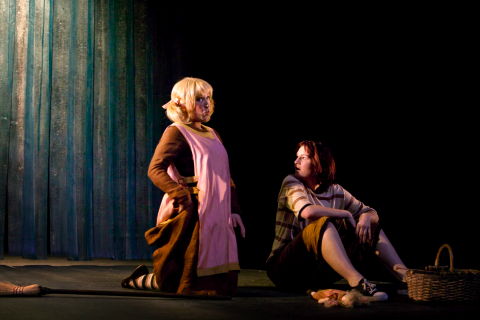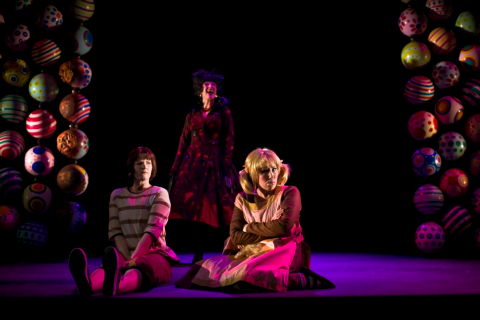|

Indelible Magic
Hansel and Gretel in New Zealand,
experienced by HOWARD SMITH
At the end of June and into August NBR New Zealand Opera showed its mettle in a enthusiastically received fifteen-centre national tour of its most recent production, an English-language version of Humperdinck's ever popular Hansel and Gretel.
We attended the Hastings performance in Hawkes Bay Opera House, the building with an art deco-Spanish mission exterior, first opened in 1915, formerly known as the Hastings Municipal Theatre Complex and recently revamped to comfortably accommodate a wider variety of local and touring entertainment.
Consider the logistics; NBR NZ Opera played in Kerikeri Centre (29 June) to the far north of Auckland, and at Invercargill Civic Theatre (25 July) -- the extreme south of NZ's South Island. These furthermost venues are separated by 1840 kilometres of road plus a 92 kilometre, three hour inter-island ferry crossing from Wellington in the North Island to Picton in the South.
During one of New Zealand's severest winters, with capricious road and sea conditions, the schedule of seventeen staging post performances from north to south with a two night season in both Wellington and Christchurch seemed perilously close to tempting fate.
Kerikeri, site of NZ's first permanent mission station (built 1821-22) with a population of 5,856 (2006) is prone to fierce storms. Invercargill, population 50,328 (2006) -- one of the southernmost cities in the world -- is NZ's furthest and westernmost city with nothing much but treacherous seas separating it and Antarctica.
The gorgeously sumptuous, entrancingly atmospheric orchestral writing by Engelbert Humperdinck (1854-1921) makes this an opera with a widespread appeal at all ages. And while musically it owes much to Wagner (1813-1883) with his extreme chromaticism and shifting tonal centres, the younger composer avoided the older man's weighty reliance on Northern European mythology, Icelandic legend and intense myth such as the German Nibelungenlied.
Hansel and Gretel is a tale of Germanic origin, adapted by Jacob (1785-1863) and Wilhelm Karl (1786-1859), the famed Brothers Grimm and earlier by Italian poet, courtier, and fairy tale collector, Giambattista Basile (1566 or 1575-1632). author of Basile's Pentamerone -- his collection of mythic Neopolitan stories.
On 6 August 2008 at nightfall, some 1340 kilometres from Invercargill by road and sea, the house lights went down and the capacity 985 Hastings opera-goers awaited a transformation to Germany's forbidding woods and playful antics of the storybook siblings.
Personally I needed a full half act adjusting to Michael Vinten's shrewd reduction of Humperdinck's rich, enchanting score; indeed were it not for sixteen highly skilled musicians of Auckland Philharmonia the illusion of a greater ensemble may not have been possible. The half dozen woodwinds had their work cut out and upper brass remained sorely missed.
As it was the show went on with two flutes, oboe, two clarinets, bassoon, two horns, keyboard, three violins, two violas, cello and bass. (South Island performances were accompanied by members of the Christchurch Symphony Orchestra.)

Ana James as Gretel and Anna Pierard as Hansel in the 2008 New Zealand Opera production of 'Hansel and Gretel'. Photo © 2008 Adrian Malloch
|
The two children -- Hansel (Anna Pierard) and Gretel (Ana James) -- soon set the scene with their frolicsome antics and skittish vocal banter. James was especially convincing with her disarming merrymaking and adroit vocals. Pierard, like most Hansels, had a harder task in nailing the jesting, supportive brother yet, to her credit, the male role worked.
Both 'ladies' were especially successful in bringing some of the captivating German inflexions to their English lines.
New Zealand's ever popular Cornwall-born Helen Medlyn seemed insufficiently distraught as a mother at her wits end though part of her dejection was made expressly clear when James Harrison appeared as the carousing, inebriate father ... 'Ral la la la, Ral la la la, heißa, Mutter, ich bin da'!!
In Act 2, I always imagined the children lost among dense conifers but designer John Verryt's corridor of over-arching deciduous, wintry trees was both menacing and adaptable as lighting effects (by David Eversfield) rapidly conveyed the shifting nocturnal moods.
Here the Auckland winds' 'cuckoo' and night-time sounds proved marvellously enchanting; in short the small orchestra stamped Act 2 with a patina of indelible magic, against which the children's calls and answering echoes were wonderfully realistic.
Pierard and James established a wholly convincing sense of foreboding in the gathering darkness before the famous evening prayer -- 'When at night I go to sleep, fourteen angels watch do keep ...'
As brother and sister slumbered, the inky black, star studded heavens were reminiscent of New Zealand's rural night skies, though the appearance of a magnificent bronze sun winking errantly on and off can only have been caused by a gremlin or witches spell affecting the lighting technicians.

Anna Pierard as Hansel, Helen Medlyn as the witch and Ana James as Gretel in the 2008 New Zealand Opera production of 'Hansel and Gretel'. Photo © 2008 Adrian Malloch
|
I hope to be excused for a 'thumbs down' over the oddball Witch's cottage with its 96 candies -- twelve rows of eight vertically hung 'beach-balls' decorated in primary colours; clever, yet kitsch in every respect.
Enter Helen Medlyn, changed from mum to witch, cackling fiendishly between her lines. Ms Medlyn appeared to revel in the diabolic role though her stomping around astride the mandatory broom in 'Herr hopp hopp, Galopp, lopp, lopp, lopp' seemed more comic than blood-curdling.
As Humperdinck's denouement dictates the cannibalistic witch got her fiery comuppance, parents and children were happily reunited, and the shades of evil were terminally dispelled.
An all-New Zealand cast and crew travelled more than 3,800 kilometres over fifty days, visiting the fifteen cities throughout the land.
In sum, here was a beloved 'fairytale' opera; distinguished by its keenly observed traditional style and rugged 'down under' stamina.
Copyright © 18 August 2008
Howard Smith, Masterton, New Zealand

| 
